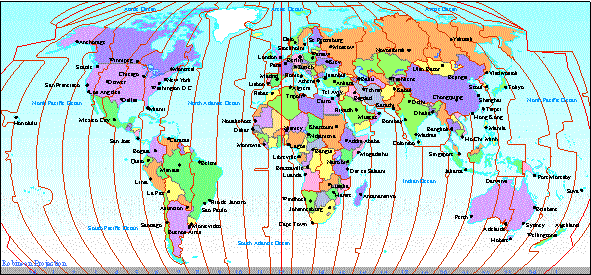 |
  |
 |
|
 |
Time
and Seasons
The
earth rotating on its axis and spinning around the
sun creates time and the seasons. It rotates once
per day (24 hours) on its axis. This gives the effect of
day and night. Our
planet orbits the sun once a year, 365 days, and because
it rotates at an angle of about 23.5 degrees from the
vertical, we experience the seasons: Summer, Winter,
Spring, and Autumn (Fall). This
then causes the variance in the length of daylight during
the year.
|
|
|
 |
|
 |
|
|
|
|
|
|
|
|
|
|
|
|
|
|
|
|
|
Notice
how the North Pole would experience 24 hours of daylight
during the Northern Summer, conversely the South Pole
would be in total darkness. The reverse applies during
the Southern Summer. So depending on your Latitude, that
is your distance from the Equator, will determine the
length of daylight each day throughout the year.
At
the Equator the sun will rise at 6:30 am and set at 6:30
pm every day. As you move away from the Equator these
times change dramatically with a change of seasons, to
the extremes mentioned with the poles. |
|
|
|
|
|
|
|
|
|
|
|
|
|
The
time zone in which we live is really a local time zone.
The reason that we have a local time zone is because
everyone likes to see the sun rise about 6:30-7 am and
set 6-7 pm.
To
achieve this and have a system for others to know our
time zone we have to appreciate the use of World Time.
World time is called either GMT or UTC. GMT is the most
common name and is short for Greenwich Mean Time. Greenwich
is a suburb of London U.K..... Longitude of 0 degrees
passes through Greenwich.
The
reason for this is historical, based on the world's first
accurate time device. Until the late 1770s East-West
navigation over long distances was not particularly accurate
because of lack of accurate timekeeping. Latitude, ie
North-South, was reasonably accurate because of the access
of the sun.
|
|
 |
|
|
|
|
|
|
|
|
|
|
|
|
|
|
|
Every
aeroplane and ship around the world operates on World
Time, GMT or UTC. The
reason being that everyone is working on the same time
reference. When
the plane or ship arrives at an airport/port the Captain
will nominate the local time. How does he/she know how
to do this?
The
world spins on its axis every 24 hours. There are 360
degrees in a circle. If you divide 24 into 360 you get
15. Hence every 15 degrees of Longitude is worth one
hour. The reference is 0 degrees at the Greenwich meridian
of Longitude.
|
|
 |
|
|
|
|
|
|
|
|
|
|
|
|
|
|
|
|
Every
15 degrees East of Greenwich is an hour ahead of GMT
because the sun rises in the East. The opposite applies
to West Longitude. Honolulu is approximately 155 degrees
West, hence the local time zone is 10 hours behind GMT.
Sydney, Australia, is approximately 155 degrees East, so
the local time zone there is 10 hours ahead of GMT.
Many
places around the world add an hour for daylight savings
to make better use of the sun for up to six months. It
is only necessary to know where and when this applies
to calculate the local time zone. |
|
|
|
|
|
|
|
|
|
|
 |
|
 |
 |
 |
|
|
|